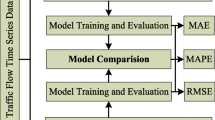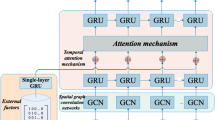Abstract
In many deep learning tasks, feature extraction and fusion in multivariate time series is an indispensable part of passenger flow prediction. Because there is also a certain correlation between passenger flow time series, it is very meaningful to successfully capture the time characteristics of the series and the dependencies between each series. Therefore, this study combined Residual Network (ResNet) and Attention Gated Recurrent Unit (Attention GRU) to build a ResGRU model for predicting subway passenger flow data during peak hours. This study has improved ResNet and attention GRU, then designed the ResGRU model architecture. Among them, the subway network topology is constructed by graphs, ResNet is used to capture the hidden spatial features between data, attention GRU captures the deep temporal features between data. This study not only considered passenger flow data, but also added subway network topology data, even weather and air pollution index data. Finally, three time solts of 10, 15 and 30 min were used to forecast the peak passenger flow on the public dataset. The ResGRU model was compared with the single model, the combined model and an ablation experiment. The experimental results demonstrate the high robustness and superiority of the model.
Access this chapter
Tax calculation will be finalised at checkout
Purchases are for personal use only
Similar content being viewed by others
References
Wang, F., Zhu, M.: 6G-enabled short-term forecasting for large-scale traffic flow in massive IoT based on time-aware Locality-Sensitive Hashing. IEEE Internet Things J. 8(7), 5321–5331 (2020)
Alipour, B., Tonetto, L., Ketabi, R.: Where are you going next? A practical multi-dimensional look at mobility prediction. In: The 22nd International ACM Conference. ACM, Utrecht, The Netherlands, pp. 5–12 (2019)
Sun, P., Aljeri, N., Boukerche A.: A fast vehicular traffic flow prediction scheme based on fourier and wavelet analysis. In: IEEE Global Communications Conference (GLOBECOM). IEEE, Abu Dhabi, United Arab Emirates, p. 2019 (2018)
Lee, K., Eo, M., Jung, E., Yoon, Y., Rhee, W.: Short-term traffic prediction with deep neural networks: a survey. IEEE Access 9, 54739–54756 (2021)
Jie, H., Zou, H., Xu, Q.: Forecasting daily MRT passenger flow in taipei based on google search queries. In: 2021 International Symposium on Computer Science and Intelligent Controls (ISCSIC). IEEE, Rome, Italy, pp. 46–50 (2021)
Liu, S.Y., Liu, S., Tian, Y., Sun, Q.L.: Research on forecast of rail traffic flow based on ARIMA model. J. Phys. Conf. Ser. 792(1), 012065 (2021)
Run, L., Min, L.X., Lu, Z.X.: Research and comparison of ARIMA and grey prediction models for subway traffic forecasting. In: 2020 International Conference on Intelligent Computing, Automation and Systems (ICICAS), pp. 63–67 (2020)
Bai, L., Yao, L., Li, C., Wang, X., Wang, C.: Adaptive Graph Convolutional Recurrent Network for Traffic Forecasting. In press
Manibardo, E.L., Lana, I., Del Ser, J.: Transfer learning and online learning for traffic forecasting under different data availability conditions: alternatives and pitfalls. In: 2020 IEEE 23rd International Conference on Intelligent Transportation Systems (ITSC) (2020)
Lana, I., Villar-Rodriguez, E.: A question of trust: statistical characterization of long-term traffic estimations for their improved actionability. In: 2019 IEEE Intelligent Transportation Systems Conference—ITSC. IEEE (2019)
Shen, C., Zhu, L., Hua, G., Zhou, L., Zhang, L.: A deep convolutional neural network based metro passenger flow forecasting system using a fusion of time and space. In: 2020 IEEE 23rd International Conference on Intelligent Transportation Systems (ITSC). IEEE (2020)
Fafoutellis, P., Vlahogianni, E.I., Del Ser, J.: Dilated LSTM networks for short-term traffic forecasting using network-wide vehicle trajectory data. In: The 23rd IEEE International Conference on Intelligent Transportation Systems. IEEE (2020)
Zhao, S., Lin, S.: Urban traffic flow forecasting based on memory time-series network. In: 2020 IEEE 23rd International Conference on Intelligent Transportation Systems (ITSC). IEEE (2020)
Shih, S.Y., Sun, F.K., Lee, H.Y.: Temporal pattern attention for multivariate time series forecasting. Mach. Learn. 108(8–9), 1421–1441 (2019)
Grigsby, J., Wang, Z., Qi, Y.: Long-Range Transformers for Dynamic Spatiotemporal Forecasting. In press
Zhao, H., Yang, H., Wang, Y., Wang, D., Su, R.: Attention based graph Bi-LSTM networks for traffic forecasting. In: 2020 IEEE 23rd International Conference on Intelligent Transportation Systems (ITSC). IEEE (2020)
Xiong, L., Hu, B., Huang, X., Huang, W.: Traffic flow prediction based on residual analysis. In: 2020 2nd World Symposium on Artificial Intelligence (WSAI) (2020)
Zhai, D., Liu, A., Chen, S., Li, Z., Zhang, X.: SeqST-ResNet: a sequential spatial temporal resnet for task prediction in spatial crowdsourcing. In: International Conference on Database Systems for Advanced Applications, (2019)
Vélez-Serrano.: Spatio-temporal traffic flow prediction in madrid: an application of residual convolutional neural networks. Mathematics 9 (2021)
Wang, B., Mohajerpoor, R., Cai, C., Kim, I., Vu, H.L.: Traffic4cast—Large-scale Traffic Prediction using 3DResNet and Sparse-UNet. In press
Barati, M., Petri, I., Rana, O.F.: Faster than real-time prediction of disruptions in power grids using PMU: gated recurrent unit approach. In: IEEE Power and Energy Society Innovative Smart Grid Technologies Conference (ISGT). IEEE, pp. 1–5 (2019)
Deng, Y., Jia, H., Li, P., Li, F.: A deep learning methodology based on bidirectional gated recurrent unit for wind power prediction. In: 2019 14th IEEE Conference on Industrial Electronics and Applications (ICIEA), IEEE, pp. 591–595 (2019)
An, Z., Feng, Z.: A stock price forecasting method using autoregressive integrated moving average model and gated recurrent unit network. In: 2021 International Conference on Big Data Analysis and Computer Science (BDACS), pp. 31–34 (2021)
Liu, L., Zhen, J., Li, G., Du, B.: Dynamic spatial-temporal representation learning for traffic flow prediction. In: IEEE Transactions on Intelligent Transportation Systems (2019)
Wu, Z., Pan, S., Long, G., Zhang, C.: Connecting the dots: multivariate time series forecasting with graph neural networks. In: Proceedings of the 26th ACM SIGKDD International Conference on Knowledge Discovery and Data Mining. ACM, pp. 753–763 (2020)
Guopeng, L.I., Knoop, V.L.: Dynamic graph filters networks: a gray-box model for multistep traffic forecasting. In: 2020 IEEE 23rd International Conference on Intelligent Transportation Systems (ITSC). IEEE (2020)
Acknowledgment
This work was supported by National Natural Science Foundation of China (NSFC)(Grant No. 62162024, 62162022), the Key Research and Development Program of Hainan Province (Grant No. ZDYF2020040, ZDYF2021GXJS003),the Major science and technology project of Hainan Province (Grant No. ZDKJ2020012), Hainan Provincial Natural Science Foundation of China (Grant No. 620MS021, 621QN211), Science and Technology Development Center of the Ministry of Education Industry-university-Research Innovation Fund(2021JQR017).
Author information
Authors and Affiliations
Corresponding author
Editor information
Editors and Affiliations
Rights and permissions
Copyright information
© 2024 The Author(s), under exclusive license to Springer Nature Singapore Pte Ltd.
About this paper
Cite this paper
Li, Y., Cheng, J., Kou, Y., Xia, D., Sheng, V.S. (2024). Prediction of Passenger Flow During Peak Hours Based on Deep Learning. In: Qiu, X., Xiao, Y., Wu, Z., Zhang, Y., Tian, Y., Liu, B. (eds) The 7th International Conference on Information Science, Communication and Computing. ISCC2023 2023. Smart Innovation, Systems and Technologies, vol 350. Springer, Singapore. https://doi.org/10.1007/978-981-99-7161-9_17
Download citation
DOI: https://doi.org/10.1007/978-981-99-7161-9_17
Published:
Publisher Name: Springer, Singapore
Print ISBN: 978-981-99-7160-2
Online ISBN: 978-981-99-7161-9
eBook Packages: EngineeringEngineering (R0)




